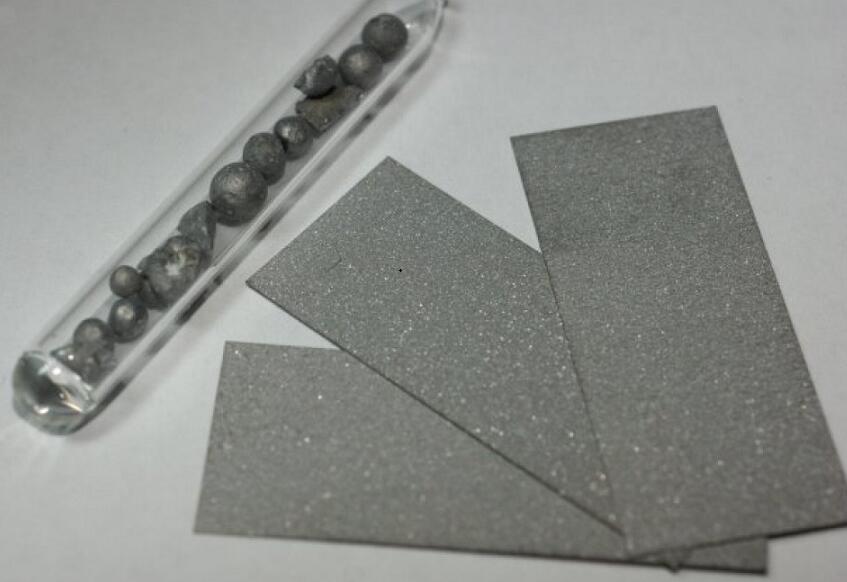Manufacturing Technology and Application of Beryllium Foil
Beryllium has the characteristics of low density, high strength, high elastic modulus, high X-ray transmittance, and fast sound propagation speed, so it is used as an aerospace analysis instrument, large-scale integrated circuit (LSI), and audio system components. In this article, let's take a look at the manufacturing technology and application of beryllium foil.

Manufacturing Technology and Application of Beryllium Foil
Manufacturing Method of Beryllium Foil
There are three manufacturing methods for beryllium foil.
1. Hot Rolling Method
First, the vacuum melted beryllium ingot is sliced, crushed, and sieved to form a uniform beryllium powder. Then the beryllium powder is vacuum hot-rolled to form a blank. This powder metallurgy method is used as the preparation method of the beryllium hot-rolled billet because the crystal grains of the vacuum-melting ingot are coarse, brittle, and difficult to plastically process.
When the beryllium blank is heated, in order to prevent oxidation, impurities from being mixed, and chill caused by the roller on the beryllium surface, it should be wrapped with soft iron and rolled into a sheet with a thickness of 1 to 2mm at a temperature of about 800 ℃. The sheet is then hot-rolled at 400 to 500 degrees Celsius to form a beryllium foil with a thickness of 0.0075 to 0.500 mm.
This kind of beryllium foil is made of fine beryllium powder about 1μm, so it is strong. However, due to oxidation when beryllium is made into powder, its purity is the lowest among the beryllium foils prepared by the three methods in this article.
2. Vacuum-Melting-Ingot-Direct-Rolling Method
First, the ingot is cut into pieces of about 220 x 200 x 90mm, wrapped in stainless steel, and then rolled at a temperature range of 790 to 980 ℃ to produce beryllium sheets with a thickness of about 5mm.
During hot rolling, too high a temperature will cause grain growth, and too low a temperature will leave a columnar crystal structure when the beryllium ingot is melted. Therefore, it is important to choose an appropriate temperature to produce a uniform and fine structure without anisotropy.
The above 5mm thick beryllium sheet is rolled at a temperature ranging from 650°C to 780°C to produce a beryllium foil with a thickness of 0.0075mm to 0.254mm. The beryllium foil prepared by this method has large crystal grains and low purity. But it has higher purity than the beryllium foil prepared by hot rolling.
3. Vacuum Evaporation Method
Put the substrate and the beryllium ingot into a vacuum evaporation furnace, heat the substrate to 400 to 500 ℃, then melt the beryllium ingot with an electron beam to vaporize the beryllium on the substrate, and then take it out of the furnace. Then separate the substrate and the beryllium to obtain a beryllium vapor-deposited film.
This beryllium vapor-deposited film can be used as the vibrating plate of the loudspeaker and some complicated parts. If the substrate is made into the shape of the part to be prepared, a beryllium vapor-deposited film in the shape of the part can be obtained, and it can be used as a part without processing.
However, because the vapor-deposited beryllium film has a columnar crystal structure, air, and helium gas leak out of the gap, so it is difficult to use it as an X-ray transmission window.
By thermally processing the vapor-deposited film, the purpose of destroying the columnar crystal structure can be achieved, and a beryllium foil that does not leak air and helium can be produced.
The vacuum evaporation method has the following advantages:
1. Because beryllium foil is made directly from beryllium ingots by vacuum evaporation, its purity is higher than that of beryllium foils made by hot rolling and vacuum-melting-ingot-direct-rolling method.
2. Manufacture thin beryllium foil with a simple process.
3. Because the beryllium vapor-deposited film prepared with fine grains is used as the raw material, the prepared beryllium foil has good strength and elongation and becomes a tough material.
Application of Beryllium Foil
Transmission Window for Accelerator Radiation
Beryllium foil is expected to be used as an X-ray source for X-ray lithography and window material for X-ray transmission generated by SR light.
Energy-Dispersive X-ray Analysis
The energy dispersive X-ray analyzer is equipped with an electron microscope and can easily branch, so the demand has been increasing in recent years. The thinner the X-ray transmission window material used in the device, the higher the X-ray transmittance, and the higher the analysis sensitivity of fluorescent X-ray light elements such as B, C, and N with long wavelengths. Therefore, the X-ray transmission window uses the beryllium foil of about 10 μm.
X-ray Tube and X-ray Camera Tube
Both X-ray tubes and X-ray camera tubes use beryllium foil as the transmission window material.
The Vibrating Plate of the Loudspeaker
The sound propagation speed of iridium is faster than that of other metals. The faster the speed of sound, the higher the resonance frequency of the loudspeaker, and the larger the range of the sound that can be heard in the high-pitched region. Therefore, beryllium has been used as the vibrating plate of the loudspeaker.
Conclusion
Thank you for reading our article and we hope it can help you to have a better understanding of the manufacturing technology and application of beryllium foil. If you want to know more about beryllium metal, we would like to advise you to visit Stanford Advanced Materials (SAM) for more information.
As a worldwide supplier of beryllium products, Stanford Advanced Materials (SAM) has over two decades of experience in the manufacture and sale of beryllium metal, offering high-quality beryllium foil to meet customers' R&D and production needs. As such, we are confident that SAM will be your favorite beryllium product supplier and business partner.









